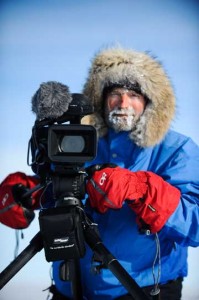
After traveling the world for years, starring in some of the ski genre’s most acclaimed films, Tom Day made the successful switch to the other side of the lens, as a cinematographer. Since then, he’s shot action sports, commercials and documentaries for top names including Warren Miller Entertainment. Day began shooting with 16mm and 35mm cameras and more recently moved to digital video. “No matter what format, I’ve been using Sachtler fluid heads from the outset,” said Day.
“When I started shooting with DSLR cameras, I admit, I tried a different, cheaper tripod. We did a test trip to Alaska late last year in preparation for our trip to photograph The Push.” Day served as the film’s director of photography and on-location director. “It follows two adaptive athletes pushing the limits and themselves in the most inhospitable place on the planet – the South Pole.”
“We learned quickly that we were up against tremendous odds,” he said. “At temperatures from 0 to -15 degrees, our equipment would seize up in the cold so I couldn’t do a simple pan. When I came back, I knew I needed new support. So, it was back to my trust in Sachtler.”
“The specs on the FSB 8 went to -40 degrees – exactly what I needed for this journey. I’d chosen the Sony NX5 and the Canon 7D cameras. I’ve found that one of the biggest mistakes people make is to undersize their tripod. When you get on the long end of the lens you get into a shaky situation, so you have to go with solid support. By choosing the FSB 8 system, we still had a lightweight, 75mm ball to attach to smaller legs, and we could go long, and handle the extremes we faced.”
Traveling to the location was not easy. Day’s equipment needed to pack easily, travel lightly and set up quickly. “I had to carry everything as we flew to Antarctica, journeyed to the staging area at Union Glacier, then flew to The Last Degree (the 89th degree below the South Pole). We then packed everything on our sleds and followed adaptive athlete Grant Korgan, as he did the 72-mile trip up to the 90th degree – the South Pole.
“We did roughly six to eight miles a day, depending on conditions,” Day explained. “The average temperature was -30 to -40 degrees. Our food, tents and so forth were tied down to our sleds, with the camera package on top. The Sachtler FSB 8 was crucial to the shoot. Since we could move faster than Grant, we stayed ahead of him. We’d find a spot, pull out the equipment, set up and shoot, then pack up and move on.”
“It got so that I didn’t even think about the cruel environment that I was putting the Sachtler through,” he added. “I trusted it so much, I knew, when it came to panning shots, no matter what the temperature, it would give me what I wanted and more.”
The Push, which follows adaptive athletes across the frozen Antarctic landscape shows the capacity of the human spirit to overcome life-altering injuries and live up to their potential, is now in postproduction. When finished, the project team will submit it to various film festivals and hopes it will also air on television.





